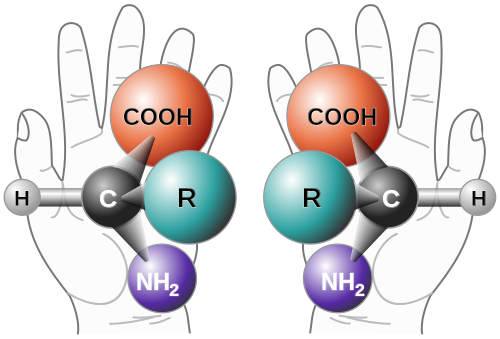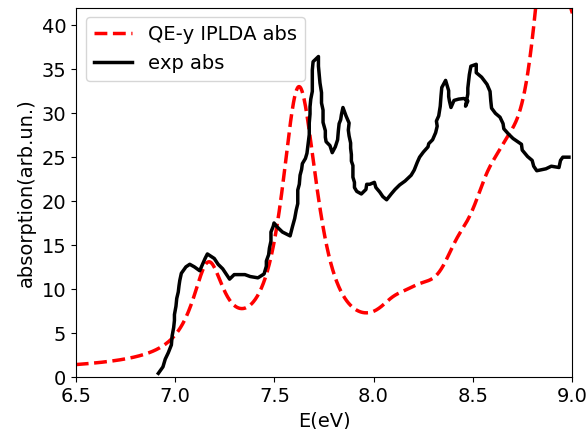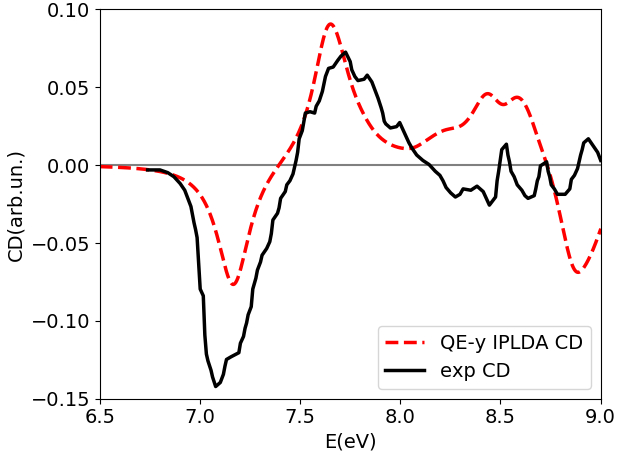Dichroism in molecules
WARNING: under construction
Circular dichroism (CD) is dichroism involving circularly polarized light, i.e., the differential absorption of left- and right-handed light[1]. Dichroism in absorption can originate from an asymmetry in the dielectric tensor, which can be induced by the presence of either an external magnetic field or a spontaneous magnetization (MCD). This can be computed from the off-diagonal elements of the dielectric tensor. See the tutorial on The magneto-optical Kerr effect (MOKE). Another form of dichroism can be due to the chiral nature of molecules or materials[2] and goes under the name of natural circular dichroism (NCD). This latter can be related to the beta tensor and will be discussed in the present tutorial.
Prerequisites
Databases
Input files
To compute NCD a standard calculation of response function in transition space needs to be performend, with the sole extra variable
BSEprop= "abs dich trace" # [BSS] abs/kerr/magn/dichr trace
Since the dipoles are obtained from a sum over states it is important to converge the number of states used in the equation, this can be controlled via the input variable
DipBandsALL # [DIP] Compute all bands range, not only valence and conduction DipApproach= "G-space v" # [DIP] [G-space v/R-space x/Covariant/Shifted grids] % DipBands 1 | 500 | # [DIP] Bands range for dipoles %
A standard input file for response function in transition space is (IP approximation
optics # [R] Linear Response optical properties bse # [R][BSE] Bethe Salpeter Equation. dipoles # [R] Oscillator strenghts (or dipoles) BSEmod= "retarded" # [BSE] resonant/retarded/coupling BSKmod= "IP" # [BSE] IP/Hartree/HF/ALDA/SEX/BSfxc % BSEBands 1 | 20 | # [BSK] Bands range % % BEnRange 0.00000 | 20.00000 | eV # [BSS] Energy range % % BDmRange 0.050000 | 0.050000 | eV # [BSS] Damping range % BEnSteps= 1001 # [BSS] Energy steps % BLongDir 1.000000 | 0.000000 | 0.000000 | # [BSS] [cc] Electric Field %
A part from this, it is suggested to set the input variable which helps the convergence in isolated systems
rim_cut # [R] Coulomb potential NonPDirs= "XYZ" # [X/BSS] Non periodic chartesian directions (X,Y,Z,XY...) RandQpts=0 # [RIM] Number of random q-points in the BZ RandGvec= 1 RL # [RIM] Coulomb interaction RS components CUTGeo= "ws xyz" # [CUT] Coulomb Cutoff geometry: box/cylinder/sphere/ws X/Y/Z/XY.. % CUTBox 0.000000 | 0.000000 | 0.000000 | # [CUT] [au] Box sides % CUTRadius= 0.000000 # [CUT] [au] Sphere/Cylinder radius CUTCylLen= 0.000000 # [CUT] [au] Cylinder length CUTwsGvec= 0.700000 # [CUT] WS cutoff: number of G to be modified
Few equations
Methyloxirane
Methyloxirane has often been used in the literature as a benchmark molecule for CD calculations against experimental data, due to its rigidity. Here we use it to show how to compute NCD using the yambo code.
Below the results at the independet particle level with converged parameters, with absorption on the left and CD on on the right from [3].
References
- ↑ Circular Dichroism on wikipedia
- ↑ Chiral Media on wikipedia
- ↑ E. Molteni, G. Cappellini, and D. Sangalli, Ab initio circular dichroism with the Yambo code: applications to dipeptides, IOP Conf. Series: Materials Science and Engineering 1265, 012005 (2022)


